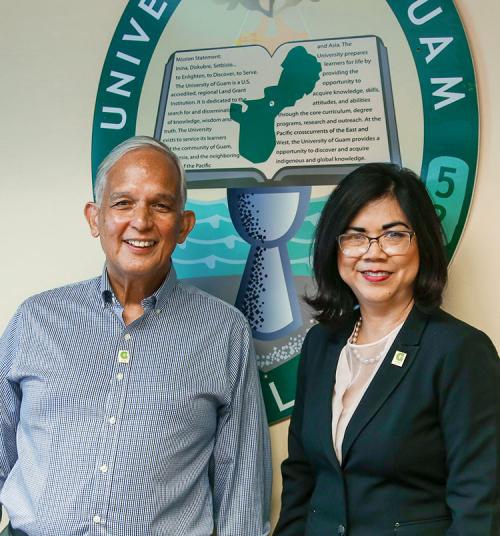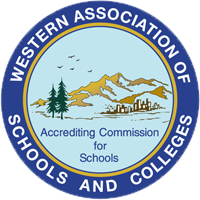UOG Announces 8 Years of Accreditation from WASC
UOG Announces 8 Years of Accreditation from WASC
UOG Announces 8 Years of Accreditation from WASC
2/15/2018
 |
| From left to right: University of Guam President Dr. Robert Underwood and Senior Vice President for Academic & Student Affairs Dr. Anita Borja Enriquez. |
WASC commends UOG’s Good to Great Initiative, Board of Regents and Fiscal Responsibility.
The Western Association of Schools and Colleges (WASC) Senior College and University Commission (WSCUC) has reaffirmed another eight years of accreditation for the University of Guam, guaranteeing that UOG has met the Commission’s high standards of quality and effectiveness.
“We are extremely proud to announce the reaffirmation of another eight years of accreditation,” said Dr. Robert Underwood, UOG President. “We received our first eight years of accreditation in 2009, and our new term will last until 2024. This accomplishment will mark an unprecedented 16 years of continuous accreditation for UOG.”
The announcement comes after the Commission evaluated the University’s institutional report and conducted a three-day on-site review in April.
“Reaffirmation of eight years of regional accreditation by the Commission is impressive, and it signals to the educational community and the public UOG's strong commitment to high quality standards and public accountability," added Dr. Anita Borja Enriquez, Senior Vice President of Academic & Student Affairs, who also served as the University’s Accreditation Liaison Officer.
In its official action letter, the Commission noted it was particularly impressed with the University’s Good to Great (G2G) initiative, calling the process “ambitious, progressive, comprehensive, and successful,” and commended the inclusion of the University’s “stakeholders, internal and external, in shaping the initiative.”
Mention of the process is threaded throughout the University’s institutional report. The Commission commented that UOG’s report was “thematically centered on the Good to Great initiative, which provided a compelling, unifying framework for the report, consistent with its role in charting the university’s course for the next five to ten years.”
The Good to Great (G2G) initiative is a process of program prioritization that began in 2012. G2G aims to transform the University in the areas of: the student experience, connectivity, financial sustainability, use of Big Data, and human resources. Each academic and administrative program was evaluated and ranked based on its fit to UOG’s mission to serve Guam and the Region, sustainability, quality, and demand relationships. All members of the University Community including faculty, staff, administrators, and students have been involved in the process since its inception.
Regarding quality assurance in both academic and non-academic planning, the Commission noted, “UOG has travelled a great distance in this regard through development of its Good to Great (G2G) initiative which has placed the quest for high quality, clear regional impact, and fiscal responsibility under a single evaluative lens. UOG is to be commended for its effort. The commitment to establishing goals commensurate with the institution’s relationship to its external environment and the prioritization of academic programs and administrative units in pursuit of those goals are progressive and, in many ways, daring.”
The Commission also praised the University’s Board of Regents in its report, characterizing the Board as “independent and engaged,” working “assiduously during the present administration to establish and maintain independence in its decision authority from the legislature,” and noting that its relationship with the legislature has served the UOG “well in terms of its board governance structures and fiscal sustainability.”
“It’s extremely uncommon for a board to receive a commendation from WASC,” added Underwood. “It speaks to our Board’s level of commitment to and support for the University and its leadership in helping us achieve our goal of becoming great.”
Also receiving commendation was the University’s strong fiscal responsibility “in the face of challenging resource constraints.” The Commission mentioned UOG’s diversification of revenue streams and its achievement of multi-year surpluses. In FY2015, UOG received 39% ($34.2M) of its total revenues from GovGuam and nearly matched that amount ($33.9M) through federal grants and contracts.
COMMENDATIONS
The Commission commended the University in seven areas:
- Taking steps to implement each of the team's recommendations immediately after the
visit. The Commission is pleased to learn of the university's efforts to: strengthen graduation
rates; invest in data management; hire additional staff to support institutional research;
institutionalize SSIT; enhance program review; and undertake co-curricular assessment.
- Designing and carrying out the Good to Great (G2G) initiative. The Commission is impressed by this ambitious, progressive, comprehensive, and successful
endeavor. The stated objective of prioritization is particularly commendable, as is
the inclusion of the university's stakeholders, internal and external, in shaping
the initiative.
- Demonstrating strong fiscal stewardship. In the face of challenging resource constraints, the university has achieved multi-year
financial surpluses. The diversification of revenue streams has been critical to
the university's financial sustainability. The Commission applauds senior leadership
for its fiscal discipline and for aligning resources with institutional priorities.
- Developing an effective relationship with the Board of Regents. As reported by the team, the board is actively engaged, strongly independent, fully
autonomous, and highly supportive of the University of Guam.
- Focusing on regional needs. The university has demonstrated a deep commitment to regional needs and the public
good through education, research and service.
- Strengthening first-year retention to 74.5%. The University of Guam has implemented a range activities and practices that are
leading to student success.
- Creating a remarkably inclusive, collaborative culture focused on good university citizenship. The G2G process, in addition to a number of university initiatives, reflects this approach to collaborating across constituencies, in order to break down silos, create synergies, and forge a new unified direction for the university.
"We are thrilled with this outcome,” said Enriquez. “The seven commendations presented by the Commission demonstrate the collective commitment of the University community to institutional effectiveness, student success through retention and degree completion, high academic quality, fiscal sustainability, and relevant public value.”
RECOMMENDATIONS
The Commission also recommended the University continue its work in five areas.
“The recommendations are works in progress that are currently being addressed by G2G,” added Underwood.
The Commission identified the following issues for further development:
- Continue to focus on improving undergraduate graduation and completion rates. This includes examining why students do not return; more detailed record keeping,
including coding of non-degree seeking student, and disaggregating data with numbers
and percentages for off-island Micronesian students; and more sophisticated analyses
of attrition (CFR 2.10).
- Expand the institutional research function to include research and analysis of trends
related to completion, undergraduate and graduate, in addition to scheduled data reporting. This will enhance the already developing culture of data-informed decision-making
(CFR 4.2).
- Clarify the connections among multiple campus initiatives focused on student success, including the Student Success Innovation Team and the Academic Master Plans, with
the intent to understand the diversity of students' educational goals. Designate an
institutional locus of responsibility for student success to align and coordinate
initiatives and ensure accountability (CFR 2.13).
- Examine the academic program review process with an eye to clarifying the purpose, strengthening the impact, simplifying the procedures,
creating accountability, ensuring timeliness, removing redundancies, and integrating
the priorities from G2G into the review criteria (CFR 2.7).
- Continue to develop co-curricular assessment and implement periodic review (CFR 2.11).
For more information and to view the WASC Senior College and University Commission action letter and report, visit www.uog.edu/accreditation or on the WASC website at www.wascsenior.org.
DOWNLOAD
Commission Action Letter, Accreditation Visit, June 2016 action
Team Report, Accreditation Visit, June 2016 action
About WASC
The WASC Senior College and University Commission is a regional accrediting agency serving a diverse membership of public and private higher education institutions throughout California, Hawaii, and the Pacific as well as a limited number of institutions outside the U.S. Through its work of peer review,
based on standards agreed to by the membership, the Commission encourages continuous institutional improvement and assures the membership and its constituencies, including the public, that accredited institutions are fulfilling their missions in service to their students and the public good.
The WASC Senior College and University Commission (WSCUC) is recognized by the U.S. Department of Education as certifying institutional eligibility for federal funding in a number of programs, including student access to federal financial aid.
 WASC Senior College and University Commission
WASC Senior College and University Commission
985 Atlantic Avenue, Suite 100
Alameda, CA 94501
Phone: 510-(671) 748-9001
www.wascsenior.org
